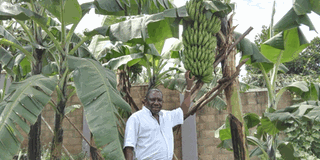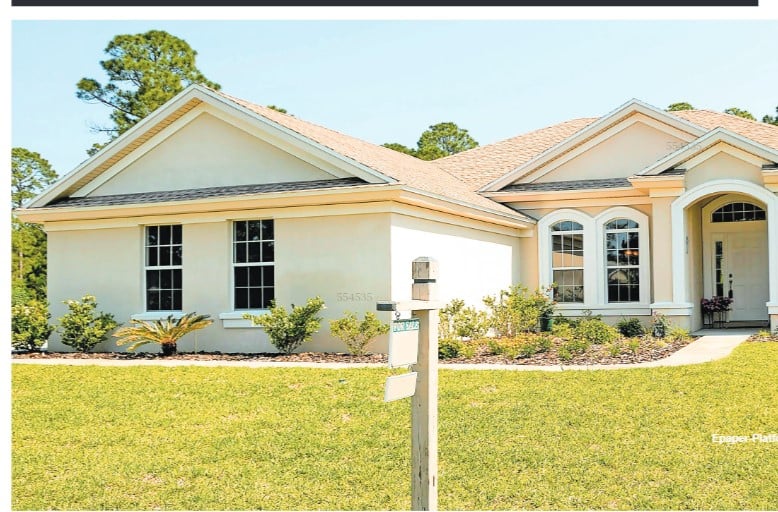Prime
How to grow tissue culture bananas

Banana researcher Erostus Nsubuga stands besides a grown tissue culture banana at a model farm in Buloba. PHOTO by DENIS BBOSA.
What you need to know:
- Tissue culture is the cloning and micro-propagation of tissues of the selected elite plants and daughter suckers.
- The process consists of five important steps: initiation, multiplication, shooting & rooting, primary hardening in green houses and secondary hardening in shade houses.
- A banana agronomist Erostus Nsubuga explains how to grow the tissue culture banana for profits, writes DENIS BBOSA.
What started as a kitchen tissue culture experiment by a retired Celtel employee Erostus Nsubuga in 2002 has metamorphosed into a full blown banana farming technology that all progressive commercial farmers must embrace to thrive. The technology had been around for a while in Makerere University labs but it took the courage of Nsubuga, an agricultural expert with an Agriculture master’s degree from Russia, to put it in practice at the time when the banana weevil disease ravaged many banana plantations in the central region.
What is tissue culture?
Plant tissue culture is a collection of techniques used to maintain or grow plant cells, tissues or organs under sterile conditions on a nutrient culture medium of known composition. Plant tissue culture is widely used in Asian countries and Europe to produce clones of a plant in a method known as micro propagation.
How tissue culture is done
During this procedure, plant cells can be removed from various parts of a plant and placed on media in petri plates. The media does not contain the growth hormones normally present in a plant that tells the cells which tissue to develop into. As a result, the cells do not differentiate and instead form a mass of cells called a callus that are not differentiated into at the tissue level.
Banana suckers
Nsubuga’s Agro Genetic Technologies (AGT) industry in Buloba along Mityana road specialises in producing vegetative propagated crops such as bananas, pineapples, coffee and potatoes.
In producing banana suckers, they get cells from the mother plant from any part; roots, leaves stem.
They then put the live cells into a glass bottle that has other nutrients so that it can multiple into millions of new cells after sometime. Nsubuga says that the outcome will resemble all the characters of the mother before it is sent out to the nursery bed from where it is served to the buyer.
This technology best applies to plants that do not require seeds according to the expert and is forbidden among humans and animals which are prescribed to undergo sex or crossing for reproduction.
Nsubuga, a plant breeder by profession and a master’s degree holder in Marketing from the US says that the tissue culture does not compromise on the local banana breeds like Kisansa, Kibuzi and Mpologoma but rather produces a disease free planting material.
Unlike the genetically modified technology, tissue culture is a humble technology that any prospective farmer can embrace from the confines of their homestead. “After getting exposure in Sweden and Asian countries like Pakistan and India, I started with less than $200 (Shs720,000) in my kitchen in Muyenga and the rest is history. We did a survey after a few months and realised we could not even satisfy the East African market by one per cent. Fourteen years on, the demand for banana planting materials in East Africa is still high that we cannot satisfy it alone,” reveals Nsubuga, the Chairman of Uganda Biotechnology and Biosafety Consortium (UBBC) and also Chairman of Tissue Culture Business Network (TCBN) in East and Central Africa.
Application of tissue culture plants
One thing is guaranteed with tissue culture, plants are produced disease free but there is no guarantee of being disease resistant. “The clean, pest and disease free banana planting tissues greatly reduce the risk of transporting virus in banana plants from one region to another,” Nsubuga expertly acknowledges.
Advices farmers embrace the technology
According to Nsubuga, also a member of the Presidential Technical Advisory Committee on Business Competitiveness in Uganda under the Presidential Investors Round Table (PIRT), a prospective farmer must have good farm management. “It is not an extraordinary banana plant but all you need is to change your farming habits. Plants behave like humans, they communicate and that is why you see pollen moving from female maize over distance to find male in cross pollination.”
Nsubuga advices farmers against putting new suckers in an old plantation to avoid contacting disease. “Do not accept any new other plant in your new plantation, it will be like getting aids from outside your marriage, the plant will reproduce at least four bunches,” says the agronomist.
Spacing
The recommended scale is three meters wide, for commercial farming, you do not need to waste land but rather use 10 by 10 metres, the hole should be 1.5 meters deep. A sucker from the nursery bed costs Shs2500.
Tips for selling banana
Modern trends have called for improvement in the marketing of the banana produce.
There are tangible benefits when a farmer upgrades from his farm gate policy of selling bananas to say the peeling method that inevitably comes with value addition.
According to Erostus Nsubuga, who owns just 10 banana plants in is meager garden; he reaps about Shs2.5m a month from selling his peeled bananas.
“Remember, a banana finger is 30 per cent covered by the peel. Why do you sell the peel with it, yet you can get it to feed your cows that in return will give you milk and manure to replenish the garden?”
Yet at market vending, a bunch of banana now goes at Shs40,000 in most Kampala markets but a peeled banana can reap about Shs70,000.
One acre can accommodate about 450 banana plants, each sprouting three bunches.
If managed well, one acre gets a farmer about Shs27m annually with the farm gate policy; market vending can rake in Shs60m yet peeled method yields Shs90m with value addition.




